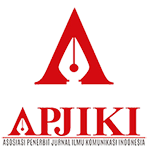PERSPEKTIF KOMUNIKASI KREATIF DI ERA DIGITAL OLEH STAKEHOLDER ILMU KOMUNIKASI UDINUS
Abstract
Dominasi Teknologi Informasi dan Komunikasi, telah membuka lembaran baru dimana masyarakat bisa memperoleh informasi secara mandiri. Sekat-sekat informasi dengan sendirinya menghilang oleh inisiatif kuat individu yang ingin mengetahui lebih jauh apa yang terjadi sekitarnya. Era yang penuh akan muatan nilai-nilai ide, konsep, kreativitas, dan inovasi ini membutuhkan kompetensi unik, spesifik, dan menarik yang harus dimiliki sarjana ilmu komunikasi dalam berkompetisi. Keberadaan media sosial semakin memperkuat peran kreatifitas bagi perusahaan untuk bisa menjangkau khalayak milenial secara terintegrasi dan interaktif melalui strategi komunikasi pemasaran.Penelitian kualitatif ini mengeksplorasi lebih jauh implementasi yang efektif dari pengembangan berkelanjutan komunikasi kreatif. Menggunakan wawancara semi-terstruktur dan diskusi kelompok terarah (FGD), mengidentifikasi persepsi stakeholder dalam memastikan pengembangan berkelanjutan komunikasi kreatif di era digital pada program studi ilmu komunikasi UDINUS. Secara khusus penelitian ini telah menyelesaikan permasalahan penelitian yaitu Bagaimana stakeholder industri komunikasi mempersepsikan, mengalami dan mempraktikkan Komunikasi kreatif di era digital.
Keywords
Full Text:
PDFReferences
Akar, E., & Topcu, B. (2011). An examination of the factors influencing consumersattitudes toward social media marketing. Journal of Internet Commerce, 10,3567.
Banks, M., 2010. Craft labour and creative industries. Int. J. Cultural Pol. 16 (3)350 321.
Bekraf, (2017). Tenaga Kerja Ekonomi Kreatif 2011-2016Jakarta, Indonesia
Bekraf, (2015). Rencana strategis Badan Ekonomi Kreatif 2015-2019Jakarta, Indonesia
Brady, M., Fellenz, M. R., & Brookes, R. (2008). Researching the role of information andcommunications technology (ICT) in contemporary marketing practices. Journalof Business and Industrial Marketing, 23(2), 108114.
Brynjolfsson, E., & Schrage, M. (2009). The new, faster face of innovation: Thanks totechnology, change has never been so easy-or so cheap. Wall Street Journal andSloan Management Review,. Accessed 12.11.11.
Cheshire, P., Malecki, E., 2004. Growth, development, and innovation: a look backward and forward. Papers Regional Sci. 83 (1), 249267.
Creswell, J. W. (2003). Research design (2nd ed.). London: Sage
Creswell, J. W. (1994). Qualitative and quantitative approaches. Thousand Oaks, CA: Sage.
Crush, P. (2011). Filling the digital skills gap. Marketing, 13 July, 3334.
Day, G. S. (2011). Closing the marketing capabilities gap. Journal of Marketing, 75,183195.
Fast, K., Ornebring, H., Karlsson, M., 2016. Metaphors of free labor: a typology of unpaid work in the media sector. Med. Cult. Soc. 38 (7), 963978.
Fung, A., 2016. Redefining creative labor: East Asian comparisons. In: Curtin, M., Sanson,K. (Eds.), Precarious Creativity: Global Media, Local Labor. University of California Press, Oakland, California, pp. 200214.
Grant, K. M., Hackney, R., & Edgar, D. (2009). Informing UK information manage-ment pedagogic practice: The nature of contemporary higher education culture.International Journal of Information Management, 30(2), 152161.
Hamill, J., Tagg, S., Stevenson, A., & Vescovi, T. (2010). Editorial: Special edition Newdevelopments in online marketing. Journal of Marketing Management, 26(34),181186.
Hesmondhalgh, D., Baker, S., 2008. Creative work and emotional labour in the television industry. Theory Culture Soc. 25 (78), 97118.
Hoffman, D. L., & Novak, T. P. (2011). Marketing communication in a digital era.Marketing Management, 20(3), 3643.
Jarvinen, J., Tollinen, A., Karjaluoto, H., & Jayawardhena, C. (2012). Digital and socialmedia marketing usage in N2N industrial section. Marketing Management Jour-nal, 22(2), 102117.
Kaplan, A. M., & Haenlein, M. (2010). Users of the world, unite! The challenges andopportunities of social media. Business Horizons, 53, 5968.
Karlsson, C., Zhang, W. (2001). The role of universities in regional development endogenous human capital and growth in a two-region model. Ann. Regional Sci. 35 (2), 179197.
Kertajaya, Hermawan, Kotler, Philip. (2017). Marketing 4.0. Moving from traditional to digital. Wiley, Canada.
Kertajaya Hermawan. (2016). Citizen 4.0, Menjejakkan prinsip-prinsip digital pemasaran humanis di era digital. GPU, Jakarta.
Klingberg, T. (2009). The overflowing bra information overload the limits of workingmemory. New York: Oxford University Press.
Kung, L. (2008). Strategic management in the media: Theory to practice. London: Sage.
Lee, H.-K., 2014. Transnational cultural fandom. In: Dutis, L., Zwaan, K., Reijinders, S. (Eds.), Ashgate Research Companion to Fan Cultures. Farnham, UK. Ashgate, pp. 195206.
Levy, P., & Birkner, C. (2011). Digital marketing 2011: What you need to know.Marketing News, 45(3), 1014.
Lowe, B., & Laffey, D. (2011). Is twitter for the birds? Using twitter to enhance studentlearning in a marketing course. Journal of Marketing Education, 33(2), 183192.
Mangold, W. G., & Faulds, D. J. (2009). Social media: The new hybrid element of the promotion mix. Business Horizons,52(4), 357365.
McAfee, A., & Brynjolfsson, E. (2012). Big data: The management revolution. HarvardBusiness Review, October 2012, 6068.
Michaelidou, N., Siamagka, N., & Christodoulides, G. (2011). Usage, barriers and mea-surement of social media marketing: An exploratory investigation of small andmedium B2B brands. Industrial Marketing Management, 40(7), 11531159.
Micu, A. C., Dedeker, K., Lewis, I., Moran, R., Netzer, O., Plummer, J., et al. (2011). Guest editorial: The shape of marketing research in 2021. Journal of AdvertisingResearch, 51(1), 213221.
Mulhern, F. (2009). Integrated marketing communications: From media channels todigital connectivity. Journal of Marketing Communications, 15(23), 85101.
Nilamsari, N. (2006). Entitas bisnis berbasis teknologi informasi: Analisis terhadap bisnis detikcom. Wacana Jurnal Ilmiah Ilu Komunikasi 5(18), 172-190.
Quinton, S., & Fennemore, P. (2013). Missing a strategic marketing trick? The useof online social networks by UK charities. International Journal of Nonprofit andVoluntary Sector Marketing, 18, 3651.
Schlee, R., & Harich, P. K. R. (2010). Knowledge and skill requirements formarketing jobs in the 21st century. Journal of Marketing Education, 32(3),341352.
Valos, M. J., Ewing, M. T., & Powell, I. H. (2010). Practitioner prognosticationson the future of online marketing. Journal of Marketing Management, 26(34),361376.
https://vtlo.com/creative-communication/what-is-a-creative-communication-strategy/
DOI: https://doi.org/10.32509/wacana.v18i2.919
Refbacks
- There are currently no refbacks.

This work is licensed under a Creative Commons Attribution-NonCommercial-ShareAlike 4.0 International License.
Indexed by:
Recommended Tools :
Wacana: Jurnal Ilmiah Ilmu Komunikasi
Fakultas Ilmu Komunikasi, Universitas Prof. Dr. Moestopo (Beragama)
Kampus I, Jl. Hang Lekir I/8 Jakarta Pusat, Indonesia 10270
WA: 085714422271 (Chat Only)
email: wacana@dsn.moestopo.ac.id
Copyright (c) 2025 Wacana: Jurnal Ilmiah Ilmu Komunikasi
Licensed under a Creative Commons Attribution-ShareAlike 4.0 International License.













